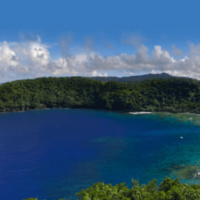
American Samoa and Palau – separated by 4,000 miles of land and ocean, have signed a memorandum of understanding agreement which officially recognizes Palau National Marine Sanctuary as a sister site to the National Marine Sanctuary of American Samoa.
The agreement also introduces a framework for regional collaboration that includes Papahānaumokuākea Marine National Monument in Hawai’i.
The MOU will make it easier for ecosystem managers and scientists in the United States Pacific Region and Palau to share knowledge and experience, which will benefit natural resources and wildlife throughout the region, as well as the communities who depend on them.
“We are excited to have Palau join our sister site network,” said John Armor, director of NOAA’s Office of National Marine Sanctuaries. “By working as sister sanctuaries, resource managers in Hawaii and American Samoa can better collaborate with their counterparts in Palau and we’ll be able to learn from each other’s experiences in a way that helps improve the marine resources and livelihoods of Samoans and Palauans alike.”
American Samoa has been a territory of the United States since 1900.
The United States and Palau have a relationship that dates back to 1947, and since Palau established independence as a sovereign nation in 1994, the relationship between the two nations has remained strong, including cooperation on a number of international issues. In terms of ocean resources, both countries are part of the Pacific Islands Ocean Observing System (PacIOOS), a regional collaboration to collect real-time data on ocean conditions, forecast future events, and develop user-friendly tools for sharing and accessing information.
American Samoa and Palau both have a history and reputation as leaders in ocean conservation.
American Samoa was one of the first in the region to declare its territorial waters to be a sanctuary for whales and turtles, and in 2009, Palau designated its waters as the world’s first national shark sanctuary, later extending these protections to whales, dolphins, and dugongs.
All extractive activities such as fishing and mining are now prohibited in Palau National Marine Sanctuary.
National Marine Sanctuary of American Samoa is the largest national marine sanctuary in the United States’ marine sanctuary system, and its management plan includes various regulations to prevent adverse impacts to the ecosystem.




